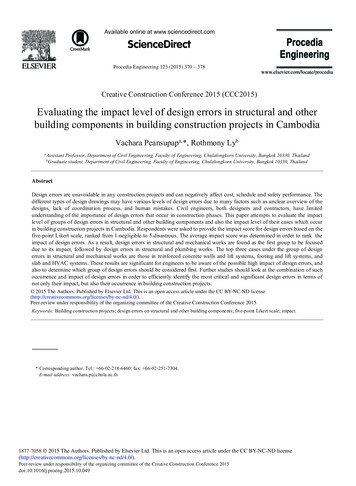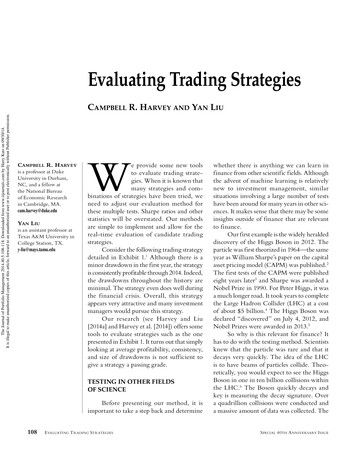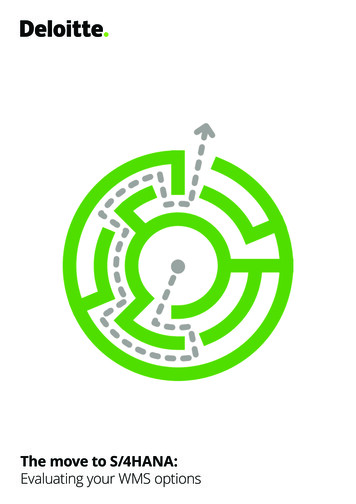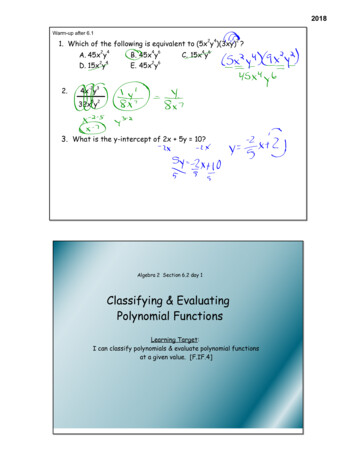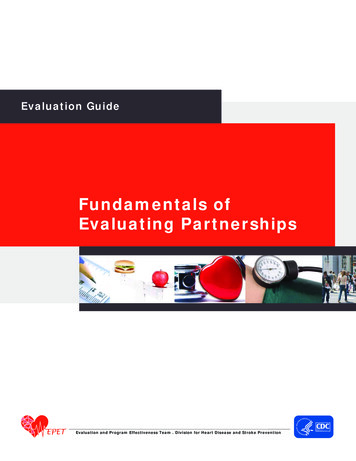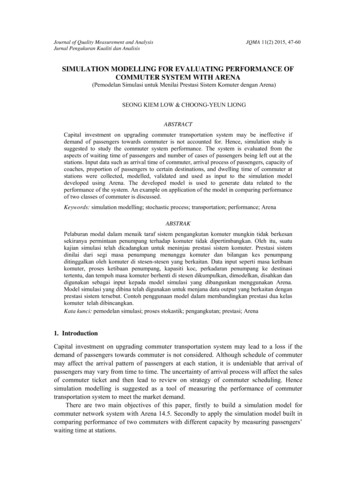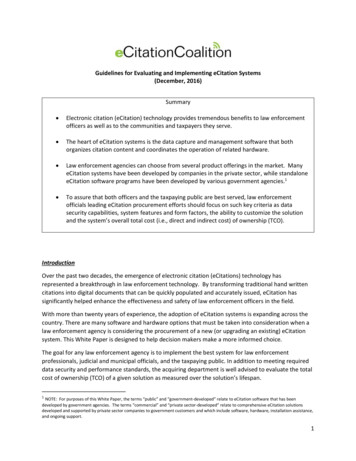
Transcription
Guidelines for Evaluating and Implementing eCitation Systems(December, 2016)Summary Electronic citation (eCitation) technology provides tremendous benefits to law enforcementofficers as well as to the communities and taxpayers they serve. The heart of eCitation systems is the data capture and management software that bothorganizes citation content and coordinates the operation of related hardware. Law enforcement agencies can choose from several product offerings in the market. ManyeCitation systems have been developed by companies in the private sector, while standaloneeCitation software programs have been developed by various government agencies.1 To assure that both officers and the taxpaying public are best served, law enforcementofficials leading eCitation procurement efforts should focus on such key criteria as datasecurity capabilities, system features and form factors, the ability to customize the solutionand the system’s overall total cost (i.e., direct and indirect cost) of ownership (TCO).IntroductionOver the past two decades, the emergence of electronic citation (eCitations) technology hasrepresented a breakthrough in law enforcement technology. By transforming traditional hand writtencitations into digital documents that can be quickly populated and accurately issued, eCitation hassignificantly helped enhance the effectiveness and safety of law enforcement officers in the field.With more than twenty years of experience, the adoption of eCitation systems is expanding across thecountry. There are many software and hardware options that must be taken into consideration when alaw enforcement agency is considering the procurement of a new (or upgrading an existing) eCitationsystem. This White Paper is designed to help decision makers make a more informed choice.The goal for any law enforcement agency is to implement the best system for law enforcementprofessionals, judicial and municipal officials, and the taxpaying public. In addition to meeting requireddata security and performance standards, the acquiring department is well advised to evaluate the totalcost of ownership (TCO) of a given solution as measured over the solution’s lifespan.1NOTE: For purposes of this White Paper, the terms “public” and “government-developed” relate to eCitation software that has beendeveloped by government agencies. The terms “commercial” and “private sector-developed” relate to comprehensive eCitation solutionsdeveloped and supported by private sector companies to government customers and which include software, hardware, installation assistance,and ongoing support.1
What is eCitation?In recent decades, eCitation systems have evolved from standalone e-ticketing software to completehardware and software solutions, often with wireless networking technologies that transfer data tocourt and law enforcement databases for ticket processing and data analysis. Typical eCitation systemsuse a smart device (laptop, tablet or handheld computer) and a mobile printer, coupled with datacapture and data management software.These systems, which replace inefficient handwritten citation processes, offer higher efficiency andproductivity. With less time devoted to manually issuing and recording tickets, officers can cover moreground when on duty while enhancing both their and the public’s safety by spending less time ondangerous roadsides. Digital data entry and automatic formatting produce organized, legible andaccurate citations with fewer errors and fewer dismissals in court. This leads to both the recapture ofrevenue that is currently lost to errors common to handwritten tickets and the additional benefit offaster revenue collection for the issuing jurisdiction. Today’s eCitation systems can capture, store andtransmit data, making it available for analysis by the law enforcement agency and other governmentalorganizations in near-real time.High functioning eCitation systems can: Quickly capture all information on the driver’s license by scanning a 2D barcode included on theback of all licenses. The data is used to automatically populate all appropriate fields on thecitation form prior to printing. Offer options for issuing multiple violations and warnings at one time. This allows officers toquickly search a local database of hundreds or even thousands of offenses. Automatically print the different types of tickets, including: traffic, parking or code enforcementcitation. Give the officer the option to capture the violator’s signature, a digital photo, or even afingerprint. Synchronize and submit citation data wirelessly to the law enforcement agency’s recordmanagement system (RMS) and any other government entity provided access to the system. Allow authorized system users to access tickets online through a desktop or mobile application,reproduce them in the appropriate format, and export the information to relevant courts. Inaddition, the web application stores all aggregate ticket data, which can be used to createreports for future analysis.Adoption RatesToday, most states have authorized the use of eCitation systems and hundreds of law enforcementagencies have systems in place. Anecdotal evidence suggests that about 60 percent of law enforcementagencies in the U.S. have adopted some form of eCitation.Even in states that have authorized the use of eCitation systems, not all law enforcement agencies haveemployed them. For example, according to a March 2015 Statewide eCitation Study by the Minnesota2December, 2016
Judicial Branch, State Court Administration, 63% of Minnesota’s citation volume is currently submittedelectronically by 258 of the state’s law enforcement agencies. The remaining 37% are paper citationsissued by the 181 Minnesota law enforcement agencies that have not yet made the transition, thoughthe State’s Supreme Court mandated that all law enforcement agencies in the state transition toeCitation by July 1, 2016.The Value of eCitationVirtually every level of state, county and municipal government benefits from the implementation ofeCitation systems. Stakeholders include executive and legislative branch officials as well as judges andcourt officials, Sheriffs and police departments, individual patrol officers, and the general public. In anera where municipal budgets are tight and the search for more cost-effective ways to govern is ongoing,eCitation systems offer a rapid return on investment, often in less than a year’s time.Some states are leading the way in developing funding mechanisms to help implement eCitationsystems. Illinois, Tennessee and Virginia have passed legislation that adds a fee to traffic tickets tocreate specific funds that support the purchase and maintenance of eCitation systems by lawenforcement agencies. Similar legislation has been introduced in several other states, including (inalphabetical order) Alaska, Arkansas, Georgia, Hawaii, Maine, Maryland, Mississippi, Missouri, NewMexico, New York, Oklahoma, Pennsylvania, Rhode Island, and South Carolina. The state of Wyominghas implemented a grant program that allows Sheriff’s and police departments to apply for funding forthe purpose of implementing an eCitation Solution. In its model eCitation funding legislation, theeCitation Coalition recommends a 5.00 fee be added to citations which result in a plea of nolocontendere, a plea of guilty or a verdict of guilty. The fee is to be paid by offenders and proceeds are tobe exclusively used to help purchase, maintain, and refresh eCitation systems. Under the Coalition’smodel bill, 1.00 of the fee is to be retained by the relevant court while 4.00 of the fee is to beprovided to the issuing law enforcement agency.Where implemented, the fee has been very helpful to law enforcement. A July 8, 2015 story in The AltonTelegraph stated that Madison County, Illinois began adding a 5.00 eCitation fee in 2011 to all traffictickets issued in the county. Madison County Circuit Clerk Mark Von Nida noted that the fee hasgenerated approximately 250,000 since it was instituted and that, under Illinois law, 3.00 of the fee issent to the Circuit Clerk’s restricted fund while 2.00 of the fee is dedicated to assisting the issuing lawenforcement agency with eCitation procurement. According to Circuit Court Clerk Von Nida, the AltonPolice Department has received approximately 25,000 for use in purchasing and implementingeCitation.Technology ConsiderationsWhen implementing eCitation systems, law enforcement agencies must consider the key systemcomponents:Smart devices: Regardless of whether a law enforcement agency is using an eCitation system, manypatrol vehicles are currently equipped with laptops, tablets, and handheld computing devices. TheeCitation Coalition has found that the law enforcement community is trending away from the use ofruggedized laptops and toward the use of ruggedized tablets, handheld computers, and in some cases,their personal devices, which typically offers an average cost savings of 40%. The mobile nature of3December, 2016
tablets enables officers to take pictures at the scene, collect an electronic signature, record an interviewwith a witness, issue a citation or a complete report, and access data systems – all key functions in theimplementation of eCitation solutions. Peripherals such as wireless keyboards can be added to tablets,bringing their functionality to the same level as a ruggedized laptop at a fraction of the cost.Printers: In addition to the laptop, tablet, or mobile computing devices running the software application,an eCitation system requires a smart mobile wireless printer, such as those produced by ZebraTechnologies, Brother Mobile, and those distributed by L-Tron Corporation. These devices are typicallylightweight, battery-powered thermal printers which generate clear, legible citations with all relevantfields populated. Mobile wireless printers used for eCitations include full-page to 3 and 4-inch formats,with a wide variety of mounts designed to fit the limited space within vehicles.Thermal printers are compact and lightweight for easy handling and are capable of high-speed, highresolution printing that results in crisp, readable text, graphics, illustrations, maps, photos, and barcodes with maximum versatility and value.Platform interoperability, flexible networking, and connectivity options are also important as theyensure that the printer will operate seamlessly across multiple operating platforms and devices, such asiOS , Android , Windows , and Windows Mobile.Data capture and management software. eCitation software enables law enforcement agencies tocreate electronic versions of all necessary documents and automatically process those documents.There are two basic options: (1) Government-developed software and (2) total solutions developed byindependent software vendors (ISVs) and value added resellers (VARs).For example, TraCS (Traffic and Criminal Software) is a data collection and reporting software programdeveloped by government that automates the capture and transfer of incident data in the field. It isadministered by and receives ongoing support and upgrades from a coalition of users called the NationalModel for the Statewide Application of Data Collection and Management Technology to ImproveHighway Safety. The National Model also supports TraCS Web, a browser-based version of TraCS.2TraCS was initially developed by the Iowa State Police under a grant from the U.S. Department ofTransportation and is available for use by any law enforcement agencies. To date, it has beenimplemented by agencies in 13 states, though not all law enforcement agencies in those states havechosen to use TraCS.Other state and local law enforcement agencies use commercial software developed and/or distributedby companies including: Advanced Public Safety (APS), Bluestar, Cardinal Tracking, Quicket Solutions,Saltus Technologies, ScanSource, SceneDoc, Thin Blue Line Reporting, and Brazos by Tyler Technologies.Unlike the TraCS system which requires the law enforcement agency to purchase all hardware and useits own IT staff to customize, install, train and maintain the system, commercial software programs tendto be complete, end-to-end solutions that fully combine software and hardware to provide a totaleCitation system that can be fully integrated with other data collection and processing systems.Additionally, and unlike government-developed eCitation software, private-sector developed solutionsare often fully customizable, and offer each agency the ability to conform tickets to their standards. Incontrast, government-developed systems like TraCS have less flexibility and can require expensive2In addition to TraCS, there are other state government agencies which have developed eCitation software comparable to TraCS.4December, 2016
design changes to meet individual agency-customer needs. The cost of those design changes aresignificant and often surpass the total cost of procuring a commercial system.A typical commercial software solution enables police officers to create tickets using laptops, tablets, orhandheld computers. With a barcode scanner, officers record violator data from drivers’ licenses. Thesoftware typically prompts officers through the ticket-issuing process to add charges, capturesignatures, and photos related to the stop. Fines are automatically calculated based on offense, andmultiple violations can be quickly issued. Court dates, statutes, and fine amounts can also be assignedautomatically. Some software solutions include an up-to-date electronic list of municipal codes andstate statutes as well as a search tool for identifying specific violations. Violations can be immediatelyuploaded via a wireless system or uploaded from mobile devices at the end of the officer’s shift.A web application in many software programs allows departments to manage users, tickets, statutes,and court dates. The web-based software also provides reporting and export tools to eliminate reentering ticket da
court and law enforcement databases for ticket processing and data analysis. Typical eCitation systems use a smart device (laptop, tablet or handheld computer) and a mobile printer, coupled with data capture and data management software. These systems, which replace inefficient handwritten citation processes, offer higher efficiency and productivity. With less time devoted to manually issuing and recording




